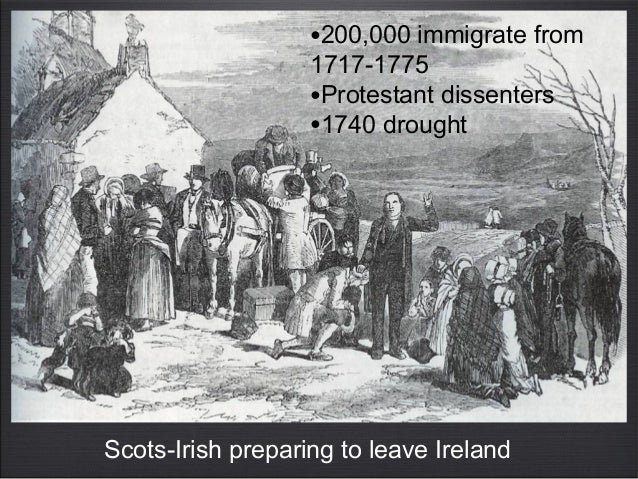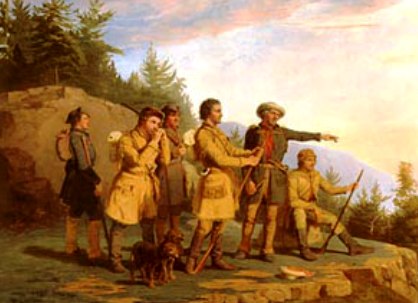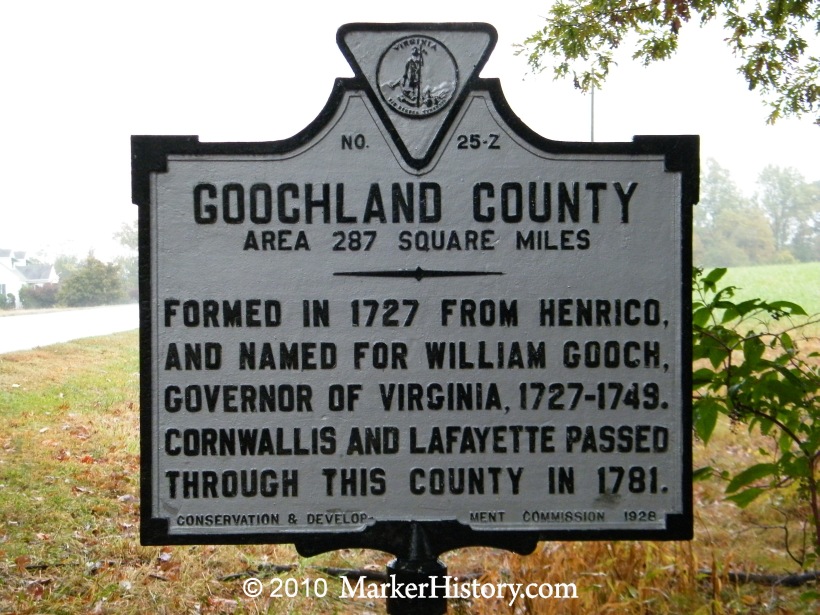The following is abstracted from The Scotch-Irish, A Social History by James G. Leyburn, published by The University of North Carolina Press, Chapel Hill, copyright 1962, ISBN 0-8078-4259-1, LOC Cat.#62-16063. This publication covers the whole migration of lowland Scots from Scotland to Ireland beginning in 1610, then to America in the 1700's, and finally, across the mountains to the Pennsylvania frontiers and down the valleys into Virginia and the Carolinas. This abstract sketches the waves of migration from Ulster to America. There were five great waves of emigration, with a lesser flow in the intervening years. An analysis of the tides of 1717-18, 1725-29, 1740-41, 1754-55, and 1771-75 provides, in effect, a chart of the economic health of northern Ireland.
This first movement, so significant as a path-opener, had as its immediate cause the years of drought; but it was the opinion of Archbishop King and Dean Swift that not even the dire effects of bad crops and high prices would have been enough to make the people move if they had not had the added goad of rack-renting*, still such a novel practice that it caused intense resentment. In a letter of 1718 to the Archbishop of Canterbury, King summed up the causes and tried to persuade his colleague to use his influence to arouse the English conscience to a realization of the effects of what was happening. He charged: "I find likewise that your Parliament is destroying the little Trade that is left us. These & other Discouragements are driving away the few Protestants that are amongst us. ...No Papists stir except young men that go abroad to be trained to arms, with intention to return with the Pretender. The Papists being already five or six to one, & a breeding People, you may imagine in what conditions we are like to be." . . .
In a sense, the emigrants of 1717 would be explorers whose report on their experiences could guide those who came after. The Ulstermen who went to Boston found unexpected difficulties and a welcome that lacked warmth. Those who followed them in the next two years were made to understand that they were not at all welcome. The people who entered America by the Delaware River, on the other hand, found a land of the heart's desire. Their enthusiastic praise of Pennsylvania persuaded others to follow them, and then still others, until by 1720 "to go to America" meant, for most emigrants from Ulster, to take ship for the Delaware River ports and then head west. For the entire fifty-eight years of the Great Migration, the large majority of Scotch-Irish made their entry to America through Philadelphia or Chester or New Castle.
*Rack-rent was simply raising the rent on the land after the period of the lease had expired, and renting to the highest bidder. Lease terms in Ulster were usually 31 years, much longer than they had been in Scotland, and were reasonable in the 17th century. As more and more immigrants came in and land became scarce landlords could get more for use of their land. However, the dispossessed, who had been there for a generation or two, were outraged.
Letters from immigrants themselves spoke of rack-rents as a determining cause of this second wave; but the Pennsylvania Gazette mentioned these as only one of the "unhappy Circumstances of the Common People of Ireland" that had resulted in so great an exodus. An article in that journal (November 20, 1729) reported "that Poverty, Wretchedness, Misery and Want are become almost universal among them; that . . . there is not Corn enough rais'd for their Subsistence one Year with another; and at the same Time the Trade and Manufactures of the Nation being cramp'd and discourag'd, the labouring People have little to do, and consequently are not able to purchase Bread at its present Rate; That the Taxes are nevertheless exceeding heavy, and Money very scarce; and add to all this, that their griping, avaricious Landlords exercise over them the most merciless Racking Tyranny and Oppression. Hence it is that such Swarms of them are driven over into America."
Famine struck Ireland in 1740* and was certainly the principal occasion for the third large wave, which included numbers of substantial Ulstermen. An estimated 400,000 persons died in Ireland during 1740-41; for the next decade there was a tremendous exodus to America. This third wave marked, on the American side, the first movement of Scotch-Irish in any numbers beyond the confines of generous Pennsylvania to the southwest. Following the path through the Great Valley, many Ulstermen now went into the rich Shenandoah Valley of Virginia, whose southern extremity opens out toward North and South Carolina. Arthur Young, writing in 1779, estimated that between 1728 and 1750 Ulster lost a quarter of her trading cash and probably a quarter of her population that had been engaged in manufacture. His comment, if accurate, suggests the caliber of men now leaving the country.
*Not to be confused with the potato crop failure that was the cause of the great Catholic Irish migration in 1845-47.
1754-55
The fourth exodus had two major causes; effective propaganda from America and calamitous drought in Ulster. A succession of governors of North Carolina had made a special effort to attract to that province colonists from Ulster and from Scotland. That two of these officials were themselves Ulstermen lent persuasiveness to their invitation and appeal. As drought ravaged the countryside, testimony of Scotch-Irish success in American struck a particularly responsive chord in hearts back home.
At this moment, however, the Scotch-Irish pioneers had their first taste of real trouble with the Indians. The French and Indian wars broke out in the colonies and were to last for more than seven years. For the time being, these violent disturbances effectively dried up the source of new immigration. More than this, Ulster was just now undergoing a true economic recovery. Her prosperity was so pronounced that the vacuum left by emigrants began to be filled by arrivals of people from the south of Ireland and from Scotland. Her population began to increase apace; indeed, it was the pressure of numbers, combined with a new economic depression, that caused the final large wave of migration.
1771-75
Young, writing in 1779, when the outbreak of the American Revolutionary War had eliminated the possibility of further emigration, said that the people of Ulster had by 1770 become very poor, living chiefly "on potatoes and milk and oat bread," and that their little farms had been divided and subdivided until "the portions were so small they cannot live on them." More than this, the shipowners at the ports of Belfast and Derry were in distress because their "passage trade, as it was called," which had long been a regular branch of commerce, was now cut off.
There was, however, a special reason for the departure of this final wave. In 1771, when the leases on the large estate of the Marquis of Donegal in county Antrim expired, the rents were so greatly advanced that scores of tenants could not comply with the demands and so were evicted from farms their families had long occupied. This aroused a spirit of resentment so intense that an immediate and extensive emigration was the consequence. During the next three years nearly a hundred vessels sailed from the ports in the North of Ireland, "carrying as many as 25,000 passengers, all Presbyterian." Froude gives an even larger figure: "In the two years which followed the Antrim evictions, thirty thousand Protestants left Ulster. ...
Religious Liberty
Throughout the fifty-eight years of the Great Migration, religious liberty had been a motive only at the beginning. It is nevertheless significant, both for Ireland and America, that those who left Ulster were almost all Presbyterians. Members of the Established Church rarely went, nor did Roman Catholic Irishmen. ...
All of the thirteen original American colonies received Scotch-Irish settlers. By comparison with the main stream that flowed through Pennsylvania, the Valley of Virginia, and the Carolina Piedmont, however, Scotch-Irish settlement in other colonies was insignificant in numbers. The strength of Presbyterianism in many of the colonies (New Jersey, for example) was not, as might be supposed, evidence of Scotch-Irish settlement, on the contrary, most of these churches had been founded by English and Welsh Presbyterians and many by immigrants directly from Scotland.
Distinction between the Scots and Ulsters
Scots in America from the first showed traits clearly different from those of the Scotch-Irish. Scots were seldom explorers, Indian fighters, or frontier traders; they played only a minor role as pioneers, preferring to settle in the east and to carry on business enterprises. Their greatest difference from their Ulster cousins, however, was seen at the time of the American Revolution: whereas the Scotch-Irish were usually ardent patriots and notable fighters in the cause of the colonies, the Scots were, with notable exceptions, Loyalists faithful to the Crown. Only in their Presbyterianism and a few of their traits of personality did they resemble the Scotch-Irish. In North Carolina the Highland Scots for a long while retained their Gaelic language and even their Highland dress.
Children and grandchildren of the original Scotch-Irish settlers in America were always among the leaders in the move to the new West; but they were no longer Scotch-Irish in their social characteristics and outlook. Just as they were likely to become Methodists and Baptists instead of remaining Presbyterians, so they were likely to marry persons whose background may have been English or German. The memory of Ulster and its respectabilities and distinctions meant little or nothing to these constant pioneers. They were Americans.
[The Scotch-Irish] moved immediately upon arrival to a region where there was neither a settlement nor an established culture. He held land, knew independence, had manifold responsibilities from the very outset. He spoke the language of his neighbors to the East through whose communities he had passed on his way to the frontier. Their institutions and standards differed at only minor points from his own. The Scotch-Irish were not, in short, a "minority group" and needed no Immigrant Aid society to tide them over a period of maladjustment so that they might become assimilated in the American melting pot. Like all people, whether immigrants or stay-at-homes, they must have known individual discouragement and disappointment; some may even have had a heightened feeling of inner loneliness, a quality of mind Weber attributes to most Calvinists who reflect upon the implications of the doctrine of predestination. But to the extent that their neighbors shared similar experiences and attitudes, without pressure from other Americans to be different, the Scotch-Irish were not ... marginal men. They were, on the contrary, full Americans almost from the moment they took up their farms in the back-country.
*Although Scotch-Irish immigrants arrived all along America’s Atlantic coast, the major flow of newcomers landed in Pennsylvania. That sea route was driven by the important trade that linked the port of Philadelphia with Ulster ports. After unloading their American cargoes in Ulster, ship captains filled their vessels with emigrants for the return trip. As more and more Ulster people traveled to America, encouraging tales of its widespread opportunities flowed back to Ulster. This migration grew steadily until the outbreak of the American Revolution; after a decade of interruption by war, it picked up again at a slower pace until the 1820s.
Most Scotch-Irish emigrants to America traveled in family groups. Upon arrival in Philadelphia, some were forced to accept indentured servitude to pay off their travel costs. But once their indenture ended, typically after seven years, they were free to pursue their own fortunes. Land in America was abundant and cheap. For decades most immigrants could take up enough land to support a family through farming, often paying only minimal fees known as quitrents. The earliest arrivals filled the fertile soils of southeastern Pennsylvania. But as the flow continued, latecomers had to seek land claims further inland. The mountainous geography of Pennsylvania’s western interior, combined with its hostile Indian inhabitants, encouraged many of them to turn southwestward instead, into Virginia’s Shenandoah Valley. That region of mild climate and fertile soils drew a steady influx of settlers from the 1720s on. But eventually the backcountry of Pennsylvania and Virginia could not accommodate all of the immigrants who kept arriving. By the time of the Revolution, and in its immediate aftermath, the flow of settlers moved onward. By the 1780s it had pushed into the western Appalachian Mountain region of the Carolinas, [Kentucky] and Tennessee. These settlers found a less favorable farming environment than their predecessors who had obtained land in the Shenandoah Valley.
*Although Scotch-Irish immigrants arrived all along America’s Atlantic coast, the major flow of newcomers landed in Pennsylvania. That sea route was driven by the important trade that linked the port of Philadelphia with Ulster ports. After unloading their American cargoes in Ulster, ship captains filled their vessels with emigrants for the return trip. As more and more Ulster people traveled to America, encouraging tales of its widespread opportunities flowed back to Ulster. This migration grew steadily until the outbreak of the American Revolution; after a decade of interruption by war, it picked up again at a slower pace until the 1820s.
Most Scotch-Irish emigrants to America traveled in family groups. Upon arrival in Philadelphia, some were forced to accept indentured servitude to pay off their travel costs. But once their indenture ended, typically after seven years, they were free to pursue their own fortunes. Land in America was abundant and cheap. For decades most immigrants could take up enough land to support a family through farming, often paying only minimal fees known as quitrents. The earliest arrivals filled the fertile soils of southeastern Pennsylvania. But as the flow continued, latecomers had to seek land claims further inland. The mountainous geography of Pennsylvania’s western interior, combined with its hostile Indian inhabitants, encouraged many of them to turn southwestward instead, into Virginia’s Shenandoah Valley. That region of mild climate and fertile soils drew a steady influx of settlers from the 1720s on. But eventually the backcountry of Pennsylvania and Virginia could not accommodate all of the immigrants who kept arriving. By the time of the Revolution, and in its immediate aftermath, the flow of settlers moved onward. By the 1780s it had pushed into the western Appalachian Mountain region of the Carolinas, [Kentucky] and Tennessee. These settlers found a less favorable farming environment than their predecessors who had obtained land in the Shenandoah Valley.












